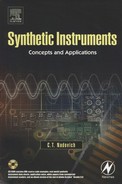Preface
My discussions ten years ago with Chris Nadovich about modular, software-based test instruments were born out of the same frustrations that are now driving the synthetic instrument movement: we were involved in integrating standard instruments into special applications for which they were not designed. As we struggled to program around unfortunate “features” and patched together solutions for new, unique capabilities, we wondered if there wasn’t a better way.
Ten years later, our ideas for this new class of instrumentation are starting to take hold in industry. When we began, we didn’t really know what to call this idea. As we have progressed from project to project, the term synthetic instrument became the widely accepted term for this new type of test equipment.
The synthetic instrument concept is as revolutionary as the forward pass was in American football. Just like the idea of actually letting go of the football and throwing it forward where anyone could catch it was a challenge to football’s status quo, synthetic instruments require a paradigm shift from instrument manufacturers. They empower the user and integrator to mold the instrument to their specific needs. Just like the early football establishment puzzled over how to run an offense that let go of the football, today’s instrument vendors puzzle over how to deal with the freedom that synthetic instruments bestow upon their customers. As hard as it would be today to imagine football without the forward pass, in the future it will be just as hard to imagine the world of test instrumentation without synthetic instruments.
Widespread adoption of synthetic instrumentation concepts has been hampered by a lack of a common vocabulary. With the revolutionary and somewhat nebulous nature of synthetic instruments, they do not fit comfortably into the language of traditional instrumentation. Since the synthetic instrument can easily be molded through software, using traditional language to describe or specify this new class of instruments tends to mold it into a reflection of the old traditional instruments. Having a terminology of its own will allow the synthetic instrument to take advantage of the full power and flexibility of the platform. This book helps create and define the lexicon for synthetic instruments.
The lack of measurement science behind synthetic instrument concepts also hinders its acceptance. Because the concepts of synthetic instruments are so new, there is a concern about how well instruments based on them will perform. For synthetic instruments to become fully accepted, the basic measurement science behind them will need to be studied and documented. This activity will take time and commitment on the part of company research organizations and academia. Until these organizations publish the necessary science and metrology to support synthetic instruments, there will continue to be reluctance to adopt them.
Over the past ten years, Chris and I have had success implementing synthetic instruments for a variety of test applications, allowing us to turn the concepts we had into reality. But as in the early stages of most revolutions, there is still considerable work ahead. Until synthetic measurement systems are mass-produced, their cost makes them uncompetitive for all but the most complex and demanding applications. Until their common lexicon is established, defining their requirements is still troublesome. The lack of documented measurement science continues to make it difficult for developers to undertake a synthetic instrument project. This book, with the work and thought that Chris has put into it, is a major step in overcoming some of the limitations we have encountered, and takes us further toward having synthetic instruments fulfill their revolutionary destiny in the test and measurement industry.
